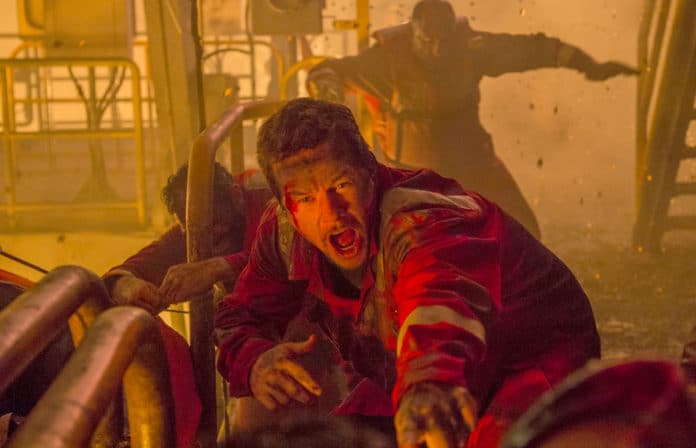The explosion of the enormous floating rig Deepwater Horizon and the ensuing oil spill into the Gulf of Mexico is well known as the worst environmental disaster in U.S. history. A buried truth within that statistic is that 11 workers lost their lives in April 2010, when pressure built up in a pipeline submerged a mile underwater, resulting in a massive blowout and fire.
“Deepwater Horizon” revisits that tragedy, reconstituting it as both a rousing action movie and a somber memorial to the dead. Directed by Peter Berg and starring Mark Wahlberg, this harrowing, gripping film in many ways resembles their last outing together, “Lone Survivor.” Like that tale of military survival and self-sacrifice, “Deepwater Horizon” is an homage to strength and get-on-with-it competence, a stirring portrait of brawn and know-how that are continually undermined by the preening ambitions of clueless elites.
In “Deepwater Horizon,” those arrogant know-nothings are the British Petroleum managers who are portrayed as rushing to exploit the potentially unstable Macondo Prospect, despite being known as “the well from hell” to the Horizon crew. John Malkovich plays BP engineer Donald Vidrine as part company man, part Cajun swamp fox, eager to get the already delayed operation underway despite warnings from Horizon crew chief Jimmy Harrell (Kurt Russell) and electronics expert Mike Williams (Wahlberg).
That setup might be simplistic – news reports suggested that Transocean, the company that operated the rig, routinely bypassed the safety systems and maintenance inspections – but it suits a movie that is less interested in slicing and dicing corporate accountability than in humanizing a story that has either been forgotten or was never fully understood in the first place.
Our guide through that tale is Williams, a U.S. Marine who seems singularly suited to the role of movie hero. As “Deepwater Horizon” opens, Mike and his wife Felicia (Kate Hudson) watch as their young daughter prepares a show-and-tell demonstration of how oil rigs work, using a shaken-up can of soda, some honey and a hollow metal cylinder. The scene is a helpful tutorial for viewers, who for the next hour will be barraged with technical jargon, quick roughneck banter and underwater shots of ominous-looking bubbles and groaning metal. And it provides a bit of convenient if unsubtle foreshadowing, when the Coke can explodes, covering the kitchen table in a puddle of sugary goo.
As Williams and his colleagues make their way to the Horizon, 41 miles off the coast of Louisiana, “Deepwater Horizon” takes on the contours of a grimly foreboding tick-tock, while crew members take part in routine checks and bureaucratic arguments and the Macondo well prepares to do its worst. When disaster strikes, about an hour into the movie, we’re put in the uncomfortable position of admiring the fiery spectacle that Berg has created with sophisticated visual effects, cinematography and editing, while being aware that unspeakable real-life suffering has been packaged for mass entertainment. Berg does a good job of maintaining a thoughtful balance between those somewhat uneasy stances, even staging a scene with an oil-covered pelican to acknowledge the ecological tragedy that would emanate from the more immediate one at hand.
Settling comfortably into his role as our cinematic elder statesman of blue-collar integrity, Wahlberg proves a sturdy, sympathetic leader on a journey to an enormous floating hellscape. In many ways, he’s the mirror image of Tom Hanks in “Sully,” another portrait of smarts, skill and unassuming courage. In that film, however, viewers are left with the reassuring image of everyone doing their jobs, up to and including the National Transportation Safety Board investigators with whom the title character clashes. While similarly engrossing and impressively staged, “Deepwater Horizon” leaves the audience with the disquieting impression that not nearly enough people did theirs.
—
Three stars. Rated PG-13. Contains prolonged, intense disaster sequences, disturbing images and brief, strong language. 107 minutes.
Ratings Guide: Four stars masterpiece, three stars very good, two stars OK, one star poor, no stars waste of time.






